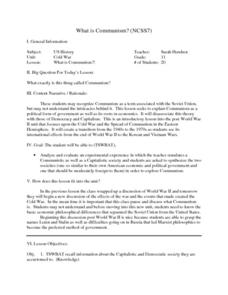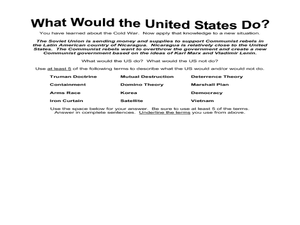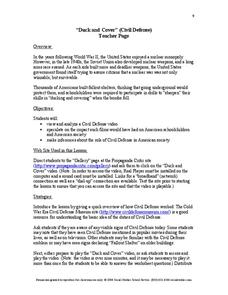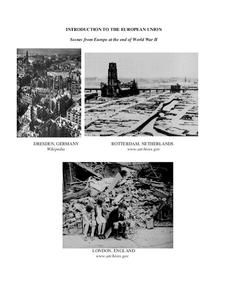Science Geek
Atomic Structure
The International Union of Pure and Applied Chemistry (IUPAC) was formed in 1919 and was crucial for allowing scientists to discuss findings during the Cold War. A presentation offers an introduction to atomic structure including the...
DocsTeach
Nixon Visits China: The Week that Changed the World
Sometimes one trip shakes up the entire world. When President Richard Nixon traveled to China, he defied international and political boundaries. Nixon was the first American president to visit mainland China, which was a communist nation...
Smithsonian Institution
Cuban Missile Crisis
The United States—specifically John F. Kennedy—played a large role during the Cuban Missile Crisis. A history resource poses questions that encourage critical thinking as well as in-depth analysis of images from the time period.
Smithsonian Institution
The Soldier’s Experience—Vietnam versus World War I
The Vietnam War and World War I were two very important—and different—wars. To understand the differences, and similarities, class members watch videos, examine primary source documents, and then create a newscast that examines the...
Curated OER
Recurring Nightmares
Does history really repeat itself? Encourage your middle and high schoolers to answer this age-old question by reading the attached articles on the Cuban Missile Crisis of 1962 and the Iraq Crisis of 2002. How similar or different are...
Curated OER
What is Communism?
Eleventh graders explore Communism. They explore Communism's roots in economics and discuss the spread of Communism in the Eastern Hemisphere. They evaluate a Communistic and a Capitalistic society. Students reflect upon the positives...
Curated OER
Brave New World
Students view a video about the effects of World War II on the map of Europe. They discuss the video and answer questions. They work together to identify accomplishments that best represent American culture.
Curated OER
The Consequences of World War II
Ninth graders explore the aftermath of World War II. In this World War II lesson, 9th graders investigate the consequences of the war as they complete a post-assessment project that requires them to compose essays on the topic.
Curated OER
The Technological impact on 1950's culture
Eleventh graders examine the 1950's. In this American History lesson, 11th graders explore the key vocabulary for the unit. Students research the new technology that existed in the 1950's.
Curated OER
What Would the United States Do?
In this U.S. history scenario worksheet, students use their critical thinking skills to explain how the U.S. would respond in a scenario that involves the Soviet Union sending support to Communist rebels in Nicaragua.
Curated OER
Mapping World War II: During and After
In this World War II learning exercise, students follow the provided instructions to mark 2 maps according to events and outcomes of the war.
Curated OER
Geographic Context for War
Students explore the geography of Korea. In this Korean War lesson, students examine maps of the country and label landforms, bodies of water, climate, population centers, and neighboring countries to determine the significance of...
Curated OER
President John Kennedy
For this President John Kennedy worksheet, learners read a 2 page article and then circle 8 multiple choice answers to 8 questions or facts referring back to the article on President John Kennedy.
Curated OER
NATO and Russia: Will the Expansion of NATO Cause a New Cold War?
Eleventh graders role play as participants in a NATO meeting focused on inviting a number of independent republics from the former Soviet Union to become members of NATO. They represent their countries after researching them.
Curated OER
Coup to Revolution: U.S. foreign Policy in Iran
Learners read and discuss the Iran country Profile from the CIA World Factbook. They describe the current relationship between the United States and Iran. Students complete additional readings, and answer questions about them. They...
Curated OER
School Desegregation in South Carolina
Eleventh graders interpret historical evidence presented in primary and secondary resources. In this North Carolina history instructional activity, 11th graders examine the Briggs v. Elliott case in order to understand the difference in...
University of California
The Vietnam War (1945 – 1975)
Have you ever wanted to do something so perfectly you wound up not doing it well at all? Young historians use primary and secondary documents to analyze the United States involvement in the Vietnam War. The issues surrounding the...
Social Studies School Service
“Duck and Cover” (Civil Defense)
Bert the Turtle models for viewers the 1950s Civil Defense Duck and Cover strategy that was supposed to protect citizens from a nuclear blast. After viewing the video, watchers are asked to consider the motivations of the producers of...
Delegation of the European Union to the United States
The Founding and Development of the European Union
How did Europe transition from a period of conflict to a period of sustained peace? As class members continue their study of the history and development of the European Union, groups examine the events in six time periods, from the EU's...
Curated OER
Emerging Democracies in Eastern Europe and Russia: How Are They Doing?
High schoolers consider the success of democracies in Eastern Europe. In this government systems instructional activity, students research the implementation of democratic practices and rule in the countries of Eastern Europe following...
Core Knowledge Foundation
Volume 2 - A History of the United States: Modern Times—Late 1800s to the 2000s
The second volume of the Core Knowledge History of the United States ebook begins by asking young scholars to consider the impact immigration, industrialization, and urbanization had on the United States in the late 1800s. The text ends...
Curated OER
Introduction To The European Union
A lot happened to European economics, policy, and social systems after WWII. This 24 page social studies packet provides images, reading passages, comprehension questions, and critical thinking questions regarding all things Europe from...
PBS
President Theodore Roosevelt: Foreign Policy Statesman or Bully?
Can a negative perception of a president's foreign policy harm his or her historical legacy? A project that winds the clock back to the date of Theodore Roosevelt's death puts students at the editorial desk of a fictional newspaper....
Humanities Texas
A President's Vision: Ronald Reagan
Young historians gain a fantastic overview of Ronald Reagan's term as president through analysis of several primary and secondary sources presented on this educational poster.
Other popular searches
- The Cold War
- Cold War Political Cartoon
- Cold War Map
- Cold War Timeline
- Space Race Cold War
- End of Cold War
- Cold War Lesson Plans
- Origins of Cold War
- Events of the Cold War
- Cold War Leaders
- End Cold War
- Canadian History Cold War

























